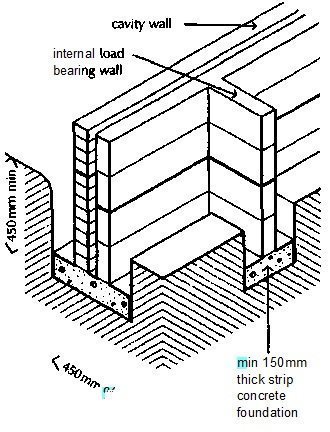Strip foundations consist of a continuous strip, usually of concrete, formed centrally under load bearing walls. This continuous strip serves as a level base on which the wall is built and is of such a width as is necessary to spread the load on the foundations to an area of subsoil capable of supporting the load without undue compaction. Concrete is the material principally used today for foundations as it can readily be placed, spread and levelled in foundation trenches, to provide a base for walls, and it develops adequate compressive strength as it hardens to support the load on foundations. Before {Portland cement} was manufactured, strip foundations of {brick} were common, the brick foundation being built directly off firm subsoil or built on a bed of natural stones.
The width of a concrete strip foundation depends on the bearing capacity of the subsoil and the load on the foundations. The greater the bearing capacity of the subsoil the less the width of the foundation for the same load.
A table in Approved Document A to the Building Regulations sets out the recommended minimum width of concrete strip foundations related to six specified categories of subsoil and calculated total loads on foundations as a form of ready reckoner. The widths vary from 250 mm for a load of not more than 20 kN/linear metre of wall on compact gravel or sand through 450 mm for loads of 40 kN/linear metre on firm clay, to 850 mm for loads not exceeding 30 kN/linear metre on soft silt, clay or sandy clay.
The dimensions given are indicative of what might be acceptable in the conditions specified rather than absolutes to be accepted regardless of the conditions prevailing on individual sites.

The strip foundation for a cavity external wall and a solid internal, load bearing wall illustrated in Fig. 6 would be similar to the width recommended in the Advisory Document for a firm clay subsoil when the load on the foundations is no more than 50 kN/linear metre. In practice the linear load on the foundation of a house would be appreciably less than 50 kN/linear metre and the foundation may well be made wider than the minimum requirement for the convenience of filling a wider trench with concrete for the convenience of laying brick below ground.
The least thickness of a concrete strip foundation is determined in part by the size of the aggregate used in the concrete, the need for a minimum thickness of concrete so that it does not dry too quickly and lose strength and to avoid failure of the concrete by shear.
If the thickness of a concrete strip foundation were appreciably less than its projection each side of a wall the concrete might fail through the development of shear cracks by the weight of the wall causing a 45?? crack as illustrated in Fig. 7. If this occurred the bearing surface of the foundation on the ground would be reduced to less than that necessary for stability.

Shear is caused by the two opposing forces of the wall and the ground acting on and tearing or shearing the concrete as scissors or shears cut or shear materials apart.
1 thought on “Strip foundations”
Comments are closed.
i really learn a lot from what i saw in your website